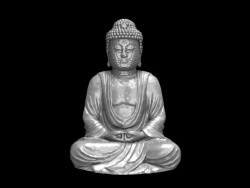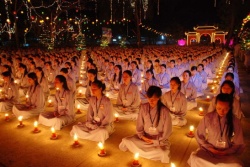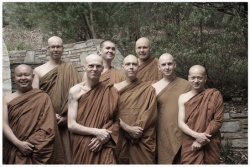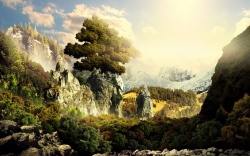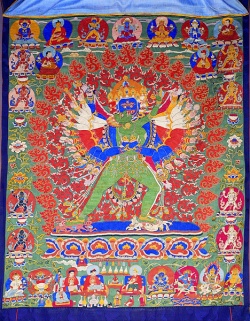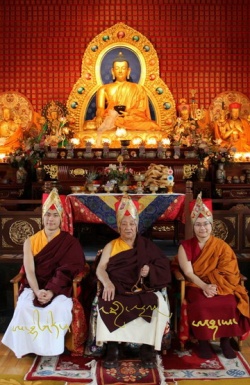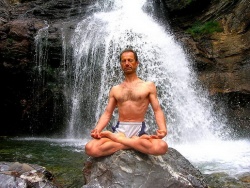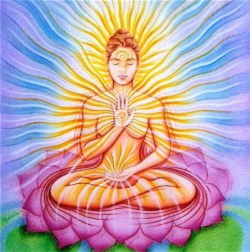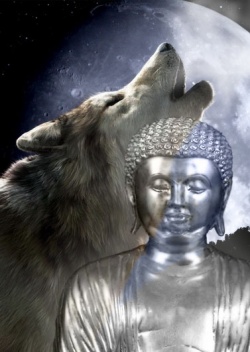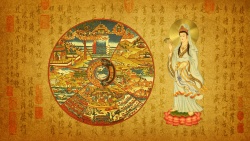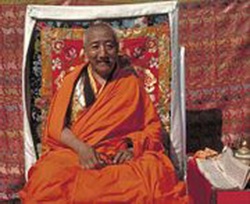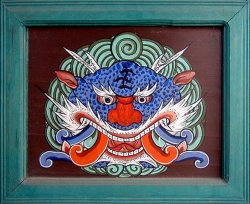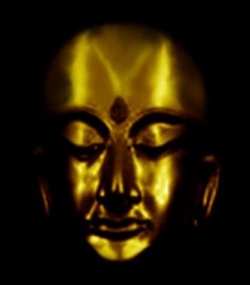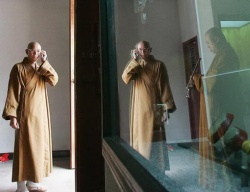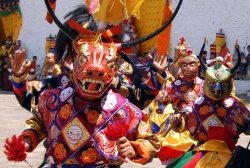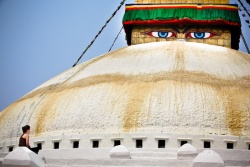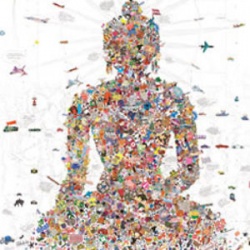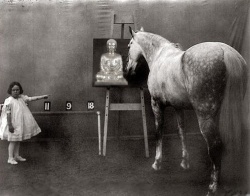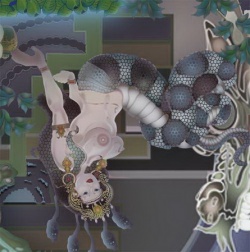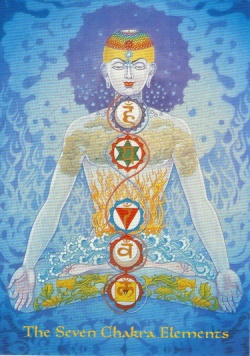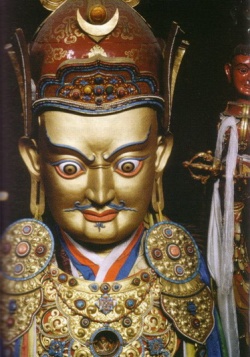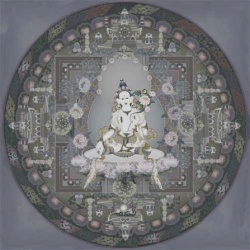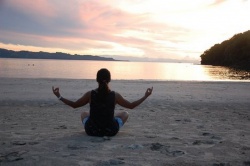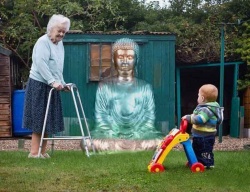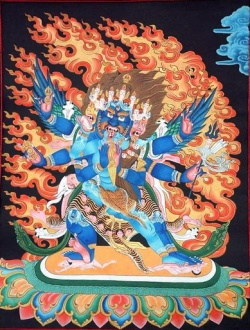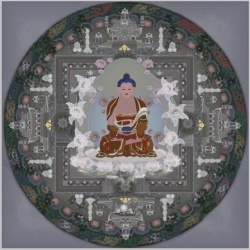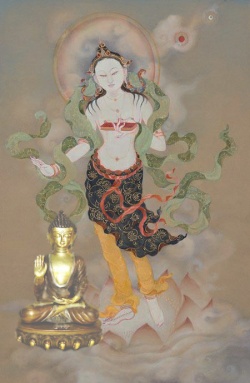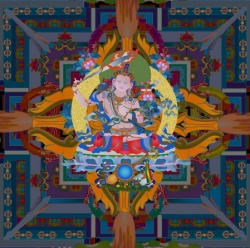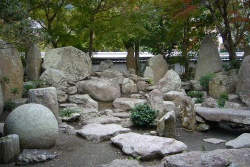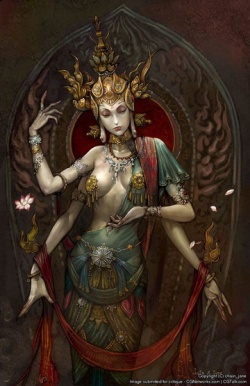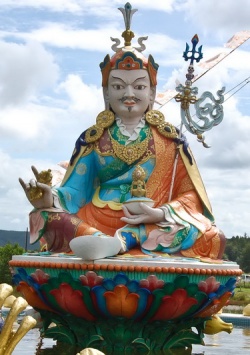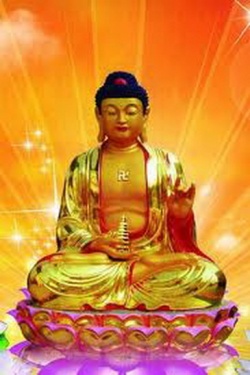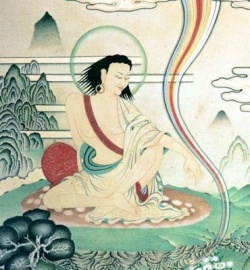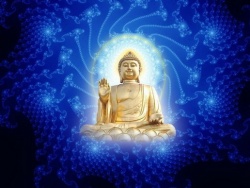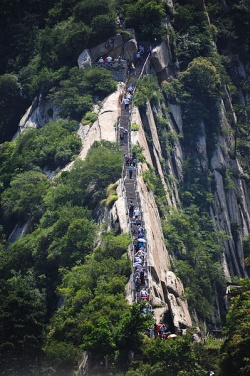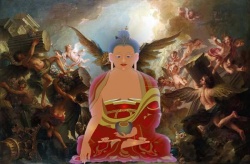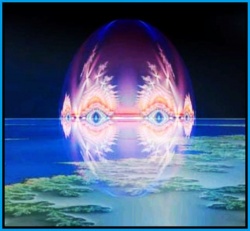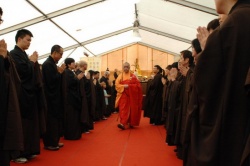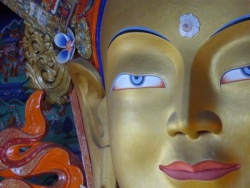A Study On The I-Pu-Tsung-Lun-Lun by Tao-Wei Liang
A Study On The I-Pu-Tsung-Lun-Lun
Tao-Wei Liang
中華學術研究院駐外副研究員
Introduction
1. Restoration of the Sanskrit titles[1]
The-I-Pu-Tsung-Lun-Lun is a book of history of the schisms which occurred in early Indian Buddhism. The original text was written in Sanskrit by Vasumitra, but the Sanskrit text is lost, and only three Chinese versions and one Tibetan version are preserved. It is impossible for us to know the original title of this text whether from the Chinese or Tibetan translations. Fortunately, however, in the beginning of the Tibetan version the transliteration of the Sanskrit title was given from which we can know that it is the equivalent of the Sanskrit title Samayabhedo-vyūhacakre according to the Sde-dge edition, or Samayabhedopara-canacakra according to the Peking edition. While in Tibetan the literal translation of this title is Gshun lugs kyi brag bkodpahihkhor lo, and Wassiljew has translated it as The Wheel of Statements (lit. arrangement) of the Dissension of Doctrines.[2] Tāranātha’s History of Indian Buddhism[3] also mentioned this text as Sde (pa) bcu brgyad kyi gshun (lungs) bye brag bkod pahihkhor lo (Treatise on the Wheel of Propositions of Eighteen Different Schools). The three different Chinese versions bear their respective titles: 1) The Ch’in version[4] bears the title Shi-pa-pu-lun (treatise on Eighteen Schools). It is supposed that this title is only the abbreviation of the Tibetan title which was mentioned in Tāranātha’s History of Indian Buddhism.[5] In Nanjio’s catalogue[6] under the Shi-pa-pu-lun he also gave the Sanskrit title Ashitādasanikāya-Śāstra, but we do not know from what origin this title was derived.[7]
2) The Ch’en version[8] was entitled Pu-chi-I-lun (Treatise on the holdings (of views) of different schools).
3) The T’ang version was entitled I-pu-tsung-lun-lun (Treatise on the wheel of propositions of different schools).[9] According to the Chi-yuan-fa-po-k’an-t’ung-lu (至元法寶勘同錄)[10] under the title of the T’ang version also gives the transliteration of the Sanskrit title in Chinese characters, and I made a hazardous attempt to restore it into Sanskrit as Prati-yamati-pada-śāstre. If my inference is correct, then it may be translated as Treatise on Against Holding up Divisions. This title seems not quite congruent with the I-pu-tsung-lun-lun. But it seems much more in conformity with the Pu-chih-I-lun. Anyhow the Tibetan transliteration of the title in the Peking edition is undoubtedly the accurate original Sanskrit title of our I-pu-tsung-lun-lun.
2. On the author
The authorship of our text is unanimously, both in the Chinese and Tibetan sources, ascribed to Vasumitra. On this point it is positively impossible for us to raise any doubt, but the point which is to be investigated is the date of the author. According to Fa-jen[11] there are, so far as the Chinese Buddhist literature is concerned, five Vasumitras:
- 1) The Vasumitra who appeared at the beginning of the third century after the nirvāna of the Buddha and who is the author of the Parakarana pāda and Dhātu kāya pāda sāstra.[12]
- 2) The Vasumitra in the fourth century after the Buddha. He was one of the four great Sthaviras at the time of the compilation of the Mahāvibhāsā in the reign of King Kaniska.[13]
- 3) The Vasumitra of the Sautrāntika school who taught a theory that even in the abstract meditation which is called extinetion (nirodhasamāpatti) there is a subtle mind.[14]
- 4) The Vasumitra who appeared a thousand years after the Buddha and whose name was given in the Abhidharmakosa sāstra.[15]
- 5) The Vasumitra from whom Hsuan-chuang learned the doctrine of the Sarvāstivāda school in Kashmir.[16]
Minayeff based on Tāranātha’s History of Indian Buddhism also enumerated five Vasumitras:[17]
- 1) The Vasumitra who lived at the time of Kaniska.
- 2) The Vasumitra who emigrated to a country neighbouring to Tokhara accompanied by Gosaka.
- 3) The famous scholar of the Vaibhāsika school.
- 4) The author of the Abhidharma sāstra prakarana.
- 5) The author of the commentary on the Abhidharmakosa and also of the work called Wheel showing the differences of the Eighteen Schools.
Most Chinese scholars are convinced that the author of our text is the Vasumitra whose comments frequently appear in the Abhidharma mahāvibhāsa sāstra. But Tāranātha deemed that the author of the Abhidharma prakarana sāstra should not be confused with the author of the Wheel Showing the Differences of the Eighteen Schools.[18] And he said that the author of our text is the Vasumitra who wrote the commentary on Vasubandhu’s Abhidharma kosa sāstra[19] We know that the first translation of our text by Kumarajiva, appeared in the fourth century A. D., and yet Kumarajiva was the contemporary of Vasubandhu, how could the author of our text become the commentator of Vasubandhu’s work? According to Rev. Yin-shun’s comment that the doctrine of Sarvāstivāda dealt with in our text is in conformity with that of Abhidharma jnāna prasthāna sāstra and Abhidharma prakaranapāda sāstra, and the doctrine of Sautrāntika is still the doctrine of the early Samkrāntivāda, which is different from the later Sautrān-tika. All these internal evidences betray that the doctrinal features of our text can not be later than the Abhidharma ma-hāvibhāsā sāstra.[20]
Concerning the life of Vasumitra there are only fragments which are found in several books: In the Buddhist Records of the Western World Hsuan-chuang has twice related Vasumitra: 1) In book Two,[21] “To the east of the city Puskarāvati there is a stupa built by Aska-rāja, this is the place where the four former Buddhas delivered the law (preached). Among former saints and sages many have come (descended spiritually) from Mid-India to this place to instruct all sentient beings. For example, Vasumitra, doctor of sāstras, who composed the Chung Sze fen opitamo (Abhidharma prakarana pada sastra) was in this place”.
2) In Book Three:[22] “At this time the venerable Vasumitra was putting on[23] his robes outside the door when the Arhats addressed him and said, If the bonds of sin (the klesas) are not loosed, then all discussion is contradictory and useless.[24] You had better go, and not dwell here.”
On this Vasumitra answered, “The wise without doubt regard the law in the place of Buddha, appointed for the conversion of the world, and therefore you reasonably desire to compile true (orthodox) sāstras. As for myself, though not quick, yet in my poor way I have investigated the meaning of words. I have also studied with earnestness the obscure literature of the three pitakas and the recondite meaning of the five vidyas; and I have succeeded in penetrating, their teaching dull as I am.”[25]
The Arhats answered, “It is impossible, but if it is as you say, you can stand by a little and presently get the condition of ‘past learning’. Then you can enter the assembly; at present your presence is not possible.”[26]
Vasumitra, “I care for the condition of ‘past learning’ as little as for a drop of spittle; my mind seeks only the fruit of Buddha; I do not run after little quests. I will throw this ball[27] up into the air, and before it comes to earth I shall have got the holy condition (fruit) of ‘past-leatning’. Then all the Arhats roundly scolded him, saying, “intolerably arrogant is your right title. The fruit of ‘past learning’ is the condition praised by all the Buddhas. You are bound to acquire this condition and scatter the doubts of the assembly.”
Then Vasumitra cast the ball into the air; it was arrested by the Devas, who, before it fell, asked him this question: ‘In consequence of obtaining the fruit of Buddha, you shall succeed Maitreya in his place (in the Tusita heaven); the three worlds shall honour you, and the four kinds of creatures (all flesh) shall look up to you with awe.[28] Why then do you seek for this little fruit?”
Then the Arhats, having witnessed all this, confessed their fault, and with reverence asked him to become their president. All difficulties that occurred in their discussion were referred to him for settlement.
In this story the description of Vasumitra’s in participation in the assembly of compiling the Mahāvibhasa sāstra is quite unbelievable, as in the Mahāvibhasa there is strong evidence, which can prove the fallacy of this story. In the 45th fascicle it says: “As the Abhidharma jnānaprasthāna sāstra has already spoken of the nature of Prthagjana, therefore the Prakarana sāstra need not repeat it again.” It is thus proven that the Prakarana was composed later than the former. Some other people have a reverse view as they say that because the Prakarana has spoken of the dharma of Prthagjana, therefore the Jnāna prasthāna will not repeat it again. Thus it proves that the Prakarana sāstra was written earlier than the Jnāna prasthāna.[29] Those compilers of the Mahāvibhāsā couldn’t even distinguish whether Katyayaniputra or Vasumitra was earlier. Because those compilers of the Vibhāsā were much later than both katyayaniputra and Vasumitra, therefore they could make such a confused supposition.
The preface of the Ārya Vasumitra Bodhisattva Sangiti sāstra has another story about Vasumitra:[30] “Vasumitra bodhisattva, the great master shall become the successive Buddha after Maitreya, and his appellation shall be called the Simhatathāgata, who had followed Sākyamuni and were born together in the same country called ‘Pi-ti’. During that time he was the son of a brahman, and his name was Uttara. Once his father sent him to see the Buddha, and also told him to stay and serve the Buddha for four months, after thoroughly see the marks, minor characteristics, and postures of the Buddha at various occasions, then come back and tell what he has seen. But he never returned to his father, because he had became a monk and changed his name to Vasumitra. After the Buddha entered into nirvāna he wandered in ‘Chou-tu’ and ‘P’ an-nai’ to teach people. He was a person of supreme talent with a free and undefiled mind. He compiled this sūtra.[31] The former seven sections (of this sūtra) are divided into thirteen chapters,[32] which were compiled by himself; while the latter four sections are collected into one chapter, which explain the Buddha’s gāthas. Thus there are altogather eleven sections in fourteen chapters. It broadly embraces all profound doctrines, and is popular even in foreign countries as parallel in importance with the Abhidharma sātras. It is related to the Mahāyāna though its peculiarity is in the revealing of the Āsravasaya (the exhaustion of transmigration). It deals vastly with the ten dharmas,[33] and exharstively describes miscellaneous practices.
“To seek it, it is vast and boundless as the ocean; how can one say it is not spacious? To climb it, it is as hign and unreachable as the peak of Mount M’un-lun;[34] How can one say it is not lofty? To look far away at the treasure isle, it is just like the light emitting pearl which shines in the night.[35] To raise eyes at the cave on the cliff, it is just like the jade of heavenly wisdom.[36] It is exceedingly rich, what can surpass this ṣūtra (sāstra)? Having climbed on a high seat, he has never fallen to the ground. After having compiled this sūtra (sāstra) he entered into samādhi, and in a ksana his spirit ascended the Tusita Heaven, where he met Maitreya, Mitrasri and Sangharaksa in the heavenly palace. Those three superior men are all bodhisattvas of the last stage. Mitrasri shall be the ‘Flame-light-tathāgatā, and Sangharaksa shall be the ‘Buddha of Gentle-kindness’. Now, the four great bodhisattvas are gathering together in one hall and discussing the upāyajnāna,[37] and the other holy sages are listening to their eloquent talks with silence. How happy they are!”
This story was written by Tao-an (道安312-385 A.D.), who, of course, learned the whole story from the translator Sanghabhūti. Though the story is a legend, yet it still reveals a part of the truth about the founder of Sautrāntika (also called Samkrāntivāda). As it is said in the Shi pa pu lun (or Treatise on the Eighteen Schools): “In the fourth century A. B. from the Sarvāstivāda again seceded another school; for the great master Uttara’s sake, this school was named Samkrāntivāda and also called Sautrāntika.”[38] And in the Kathāvathu this school was directly called Uttarāpathakas. This evidence is strong enough to support our decision that this story is not in conformity with the author of our text.
Another story about Vasumitra appears in the Sutra on Several Difficult Questions of Wei-zih:[39] “Bodhisattva Vasumitra served his master for a short time, then he left and studied the four agamas for three times. (Afterwards he came back) to scatter flowers on his master and said: ‘I have studied the four Agamas’. But the master had already forgotten him and could not even recognize who he was. Thus Vasumitra thought to himself: “I want to collect those important words from the four Agamas and to make a Sūtra, then I will preach it among the four varga.”[40] All those practisers who came to listen to the sūtra, were very much pleased. Soon the audience increased, and they engaged themselves in studying and discussing the sūtra, but they could not concentrate their minds in the practise of meditation.
Then they said to each other: “We came to listen the sūtra only for the purpose of using it to help with our meditation, now we should not study it any more, let us abandon it and resume our practice.” In the men-time Vasumitra knew their thoughts, then he put his hand in the fire, but was not burnt. Then he asked his audience saying: “Is this not fortitude?” Then he sat on a big stone as if on a soft seat, to show that he was also good at practicing meditation. Meanwhile he said to those people: “I will throw this stone in the air, before it falls on the ground I can attain arhatship.” Then he threw the stone in the air, but it did not fall, because a deva caught it in the air and said: “You are seeking for the way of a bodhisattva, and after twenty kalpas you shall attain Buddhahood; Then all devas shall get emancipation through your help, please do not give up your good desire!” There are some vulgar monks who said: “This evil person, we should not allow him stay in our country.” Then they wrote some scandalous words and went to make it known to others. Vasumitra also sent some people to seek for that letter and added some opposite words to it: “This good person, who has taught and enlightened people’s minds, yet he will not be proud, only lest those evil people shall fall into wickedness.”[41]
The legend about Vasumitra is quite old. And the Sūtra on speaking of the Various Difficulties of a Bodhisattva (惟曰雜難經) is said to have been translated by Chi-ch’ien (支謙A. D. 240). The legend in this Sutra is quite suitable to the situation of the Dārstāntika master Vasumitra. The story says: “Then Vasumitra thought: I want to collect those important words from the four Agamas and make a Sūtra is actually a sāstra, which is supposed to be the Ārya Vasumitra bodhisattva sangiti sāstra. Most of the topics in this sāstra are really based on the teachings of sūtras, and discuss and broably explain those gāthas which were taught by the Buddha.[42]
In the Buddhabhāshite simhacandra Buddha jataka sūtra it says: “There is a bodhisattva-bhiksu called Vasumitra, who wanders in the bamboo grove, and climbs up and down trees, and his voice is just like that of a monkey. Sometimes playing with three bells, he dances and sings. When elders and passersby gather to watch him, then he climbs up to the tree-top and jumps from one tree to another and makes sounds imitating monkeys……. In his last birth after Maitreya Buddha he shall accomplish the supreme way of a Buddha, and his appellation shall be the Simhacandra-tathāgata.”[43] The preface of the Ārya Vasumitra bodhisattva sangiti sāstra said that Vasumitra was the son of a Erahman, and he was born in the same age and in the same country as the Buddha. Formerly his name was called Uttara, but after he became a mnk he changed his name as Vasumitra.
The above two stories both describe that in the future after the Maitreya Buddha he shall attain Buddhahood, and his appellation shall be the Simhacandra-tathāgata. This is the same person as described in the Sūtra Speaking of the Various Difficulties of a Bodhisattva, and it has already been identified with the Dārstāntika master Vasumitra.
Again we find that in the Dharmatrāta dhyāna sūtra[44] Vasumitra’s name was placed between Upagupta and Samgharaksa. While in the Record of Sarvāstivāda[45] Vasumitra was placed between Kātyāyaniputra and Krsna. According to both Taoan[46] and Sen-jui[47] this Vasumitra is the author of the Ārya Vasumitra bodhisattva Sangiti sāstra. To sum up, in old legends all descriptions about Vasumitra bodhisattva are suitable to the Dārstāntika master Vasumitra, but later on people get it confused with the great Abhidharma master Vasumitra.
3. Works of Vasumitra
In Chinese translations of the Abhidharma-pitaka there are four works which are ascribed to Vasumitra, Viz:
- 1) Abhidharma prakarana pāda sāstra, 18 fasciculi; 8 chapters. Translated by Hsuan-chuang in A. D. 659, of the T’an dynasty.
- 2) Abhidharma dhātukaya pāda sāstra, 2 fasciculi; 2 chapters. Translated by Hsuan Chuang, A. D. 663, of the T’an dynasty.
- 3) Ārya Vasumitra bodhisattva sangiti sāstra, translated by Sanghabhūti and others, A. D. 384, of the former Ch’in dynasty. 15 fasciculi; 14 khandas.
- 4) Samayabhedoparacanacakra sāstra, translated by Hsuan-chuang, A. D. 662, of the T’an dynasty.
According to ‘Fa-jen’ the author of the first two words is not the author of the Samayabhedoparacanacakra sāstra, while in Yasomitra’s Abhidharma-kosa-vyākhyā, the author of the second work is Pūrna. Nāgārjuna in his Mahāpra-jnāpāramita-sāstra said: “Among eight chapters of the Avhidharma-prakarana-pāda-sāstra there are four chapters which were written by Vasumitra, and another four chapters were written by the Arhat of Kubhāna.”[48] Lu-chen presumed that the four chapters which were written by Vasumitra are:
- a) Discussion on all spheres.
- b) discussion on seven items.
- c) Discussion on the anusāyas.
- d) Discussion on the ascription of all dharmas.[49]
But Rev. Yin-shun said that he has found that the eight chapters of the Abhidharma prakarna aāda sāstra are really separated into two groups: the first group are inherited from the old treatises and through rewriting. The second group are a rearrangemet of the old treatises, but with some new additions. In each group there are four chapters:[50]
In the first group there are four chapters:
- a) Discussion on seven items.
- b) Discussion on the ascription of all dharmas.
- c) Discussion on one thousand questions.
- d) Discussion on discrimination of correctness.
In the second group there are also four chapters:
- a) Discussion on five items.
- b) Discussion on all wisdom.
- c) Discussion on all spheres.
- d) Discussion of the anuśāyas.
According to Rev. Yin-shun, the four cur chapters in the second group were written by Vasumitra.[51]
In regard to the third work, the Ārya Vasumitra bodhisattva sangiti-sāstra many Buddhist scholars deemed that its author is the same Vasumitra who wrote the Abhidharmaprakarna pāda sāstra, and regard it as an Abhidharma work; but they did not perceive that it is a treatise which is ascribed to the Dārstāntika master Vasumitra. Rev. Yin-shun has pointed out[52] that the Mahāvibhāsā-sāstra mentioned this sāstra as ‘The Sastra of Questions’.[53] And Vasubandhu’s Mahāyāna karmasiddha sāstra also mentiones this sāstra as ‘The Sāstra of Questions’[54], and he quotes the discussion about the subtle mind in abstract meditation (nirodhasamāpatti).
The fourth work is the I-pu-tsung-lun-lun or ‘Treatise on the Wheel of Propositions of Different Schools’, it was translated by Hsuan-chuang in the T’an dynasy A. D. 662, and it is also called the T’an-lun. As I have already mentioned the three different versions of this text in the beginning of this introduction, it is needless to repeat them here again.
4. Commentaries on the I-pu-tsung-lun-lun
The earliest commentary on this text should be Paramartha’s commentary on the “Treatise on the differences of the views of the schools”. According to the “Record of transmiting the lamp in the east” (東域傳燈錄)[55] this commentary has two editions: the edition in ten fasciculi and the edition in four fasciculi. But unfortunately, both editions are lost, and we can only see some fragments quoted in the “San-lun-hsuan-i-chien-yu-chao” (三論玄義檢幽鈔).[56]
The next one is K’wei-chi’s learned commentary on the “I-pu-tsung-lun-lun” in two fasciculi.
There are also twelve other commentaries which were written by Japanese scholars:
- 1) “Shu-chi-chian-lu” (述記講錄), in one fascicle, by Ki-ben (基弁A. D. 1718-1791).
- 2) “Shu-chi-mu-lun” (述記目論), in five fasciculi, by E-ten (榮天A. D. 1737-1801).
- 3) “Shu-chi-pi-lu” (述記別錄), 3 fasciculi, by Shin-e (信慧).
- 4) “Shu-chi-wen-lu (述記聞錄), in one fascicle,by Ryu-san (隆山A. D. 1801).
- 5) “Shu-chi-sze-chi” (述記私記), 3 fasciculi, by Kai-o (海應A. D. 1771-1833).
- 6) “Shu-chi-sze-chi” (述記私記), 3 fasciculi, by Shin-Kai (信海A. D. 1783-1856).
- 7) “Shu-chi-chian-lu” (述記講錄), 2 fasciculi, by Ho-wu (賓雲A. D. 1791-1847).
- 8) “Shu-chi-chian-lu” (述記講錄), 2 fasciculi, by Shin-shoku (神職A. D. ?).
- 9) “Shu-chi mu-ch’uan” (述記目纂), in one fāscicle, by SO-en (宗丹).
- 10) “Shu-chi-fa-jen” (述記發軔), 3 fasciculi, by Ken-e (憲榮A. D. ?-1903).
- 11) “Shu-chi-chian-i” (述記講義), one fascicle, by Koho-Terashima (寺島光法).
- 12) “Shu-chi-chian-i” (異部宗輪論講義), one fascicle, by Funabashi (舟橋水哉).
5. Other Translations
- 1) Wassiljew’s translation in German “Der Buddhismus, Seine Dogmen, Geschichteund Literatur” (1860 St. Petersburg).
- 2) Jiryo Masuda’s translation in English “Origin and Doctrine of Early Indian Buddhist Schools”.
- 3) “Kuo-i-i-pu-tsung-lun-lun” (國譯異部宗輪論) by Kimura (木村泰賢).
- 4) “Kuo-i-i-pu-tsung-lun-lun-shu-chi” (國譯異部宗輪論述記), by Shio-bun Fukaura (深浦正文).
II Causes Of The Spliting Of The Sangha
The splitting of the Sangha was by no means a sudden happening with merely a single cause, it was, however, a gradual fermentation with many causes and through several centuries. According to the account in our text (the I-pu-tsunglun-lun) the original split of the Sangha was caused by the five evil views of Mahadeva,[57] who was then living in a monastery called Kukkutārāama[58] in Kusumapūtra[59] in the Magadha kingdom, during the reign of Asoka.[60] This fact is, only one of the many causes; if we want thoroughly to know those many other causes, we must investigate those questions which were discussed in the three (or four) councils:[61]
1 The First Council
According to the tradition recorded in several different texts[62] in the Chinese translation of the Vinaya-pitaka, all unanimously say that the first council was held at Rājagṛha immediately after the parinirvāṇa of the Buddha. In the Dharmagupta vinaya[63] says that Mahākasyapa was not present at the mahāparinvāṇa of the Buddha at Kusinārā. While he was proceeding from Pāvā to Kusinārā with 500 great bhiksus, the news of the decease of the Buddha was brought to him by an ascetic of the Ajivaka sect. On hearing of this woeful news these monks who were not free from passions, were vociferous in their lamentations. Among the 500 there was then a bhiksu called Pananda[64] exhorted those monks saying: "Elders, just stop, and don't be so distressed as to cry like that! We are free from that 'makala' (fool), when he was living he often instructed us "You ought to be thus, you ought not to be thus; you should not do that." Now we are free, we can do what we like and reject what we dislike."
It may be observed in this connection that Bhānanda (or Sudhadda) was not the only person to have such thoughts. There were many others who felt that with the passing of the Buddha the Dharma he had taught would disappear. This general feeling of doubt and consternation as having been the motive for the convocation of the first council.[65]
The proceedings of the First Council achieved three results:
- 1) the settlement of the Vinaya under the leadership of Upāli.
- 2) the settlement of the Sūtra pitaka under the leadership of Anānda.
- 3) the settlement of the Abhidharma-pitaka.[66]
Besides these results there were unharmonies among the few great disciples, as in the Mahisāsaka-nikāya-pancavarga-vinaya says that after Mahākāsyapa proclaimed the settlement of the vinaya and Sūtra pitakas Ananda said to Kāsyapa: "I learned from the Buddha that after His parinirvāna if monks want to remove minor disciplines, allow them do it. " Then Kāsyapa asked Ananda: "What disciplines do you think are minor ones?" Ananda: 'I did not ask the Buddha." Why did you not ask?" "Because at that time the Bhddha was feeling pain on his body, and I was afraid that it would annoy him. "Kāsyapa then said: "Because you did not ask the Buddha you have committed the Duskrta (wrongdoing, or evil action), you should see your crime and repent before the Sangha. " Ananda said: "1 did not ask the Buddha because I was afraid that it would annoy Him. It does not mean that I hold any irreverence toward the disciplines. I cannot see there is any sign of crime in this, anyhow I will respect you and repent before the Sangha. "
Kāsyapa then charged Anand a with another crime saying that Ananda had trod upon a garment of the Buddha while sewing it as there was no one to help him. Then Anandap leaded and also made repentance before the Sangha.
Kāsyapa then charged Anand a with a third crime, because he had three times asked the Buddha to admit women into the Order of Sangha. The fourth charge is because Ananda did not ask the Buddha to stay in this world for a kalpa, though the Buddha thrice mentioned that a person who has the four supernatural powers could prolong his life to a kalpa or longer than a kalpa.
The fifth charge is because Ananda did not supply drinking water to the Buddha though He had thrice asked for it.
The sixth charge is because Ānanda had permitted some women to salute first the body of the Buddha after His parinirvāna.
Ānanda pleaded to Kāsyapa's charges one by one and also made repentances before the Sangha in order to pay respect to Kāsyapa.[67]
It was just after the trial of Ānanda, when the Venerable Pūrna arrived with his fonowers from the south and asked Kasyapa to repeat the Vinaya, the Sutra and the Abhidharma pitakas which they had just settled. Then Kāsyapa repeated them again as before. After Kasyapa finished the repeatitions, Pūrna said to Kāsyapa: "I have learned from the Buddha that (1) to keep food materials, (2) to keep cooked food, (3) to cook for oneself, (4) to take food by oneself, (5) to receive food from others, (6) to pick fruit from trees, (7) to pick fruits out of bodies of water. These seven items are allowed as not being impure. "
Kāsyapa said: "These seven items were allowed by the Buddha only temp-or arily in Vaisāli, when there was a famine and because it was very difficult to get food by begging. But afterwards, four items were prohibited in Vaisāli; and when the Buddha arrived at Rājagrha the other three items were also prohibited again. "
Pūrna said: "The Buddha should not allow at first, and then prohibited again."
Kāsyapa said: "The Buddha was the master of the Dharma, He had the sovereignty to all dharmas, even he allowed at first and then prohibied again, what error could there be?"
Then Pūrna said: "I would bear other things, on]y cannot keep these seven items!"[68]
2. The Second Council
The five different Vinaya texts[69] unanimously say that the Second Council was held at Vaisāli, a century after the parinirvāna of the Buddha. It is recorded that the monks of the Vrji country. were in the habit of practising the Ten Indulgences (dasa vatthuni) which were regarded as impurities by Yasa, and he declared these practices to be mega) and immoral in the extreme. The Ten Indulgences recorded in the four vinaya texts[70] are slightly different from each other. In the Mahisāsaka vinaya they are recorded as follows:
- 1) It is allowed to keep salt and ginger. This is not impure.
- 2) After meal time if one got extra food and picks up with two fingers and to eat is allowed. (The interpretation of the southern tradition is: To take meals slightly after mid-day, that is when the shadow is two finger broad).[71]
- 3) After a meal if there is another chance to eat one can sit down and eat again. This is allowed as not impure.
- 4) To go to another village and to have .a second meal there on the same day is allowed.
- 5) To drink honey mixed with butter is allowed.
- 6) To drink half brewed wine is allowed.
- 7) To make a cloth mat the size of one's choice is allowed.
- 8) To practice what one has learned before is allowed.
- 9) To ask someone to inquire after a friend's health is allowed.
- 10) To accept gold and silver and to keep them is allowed.
The story connected with the tenth Indulgence goes like this: "All the Vrji bhiksus on every 8th, 14th, and 15th sit together in the swarming streets with their begging bowls filled with water in front of them as a sign of auspice. When people pass by, they will point to their begging bowls and say: "For good luck please give Some money for buying cloth, bowls, shoes and medicine." Some people gave them money, some people rejected them and saying: "Sramanas, the sons of the Buddha should not receive money, even if people give money they should not look at it. Now, why should you beg for money from people?"
In the meantime. Yasa, the son of Kākandaka was in the towered meeting hall by the side of the Monkey River, he said to all bhiksus: "You should not beg for money, I learned from the Buddha that if one begs not according to the dharma, or one bestows not according to dharma, both of them are guilty."
When those bhiksus got money they offered one share to Yasa, but he refused and said: "I cannot accept the alms obtained not according to the dharma. "
Those bhiksus said: "If you do not accept, you may give it to others."
Yasa said: "As I do not accept; why should I give it to others?"
Then all bhiksus deemed that Yasa's former instruction charged and put blame on the laity, so they pronounced the penalty of patisāraniya-karma[72] upon him.
Yasa defended his own view before the laity and by his elequent advocacy won them over" to his side. This increased the fury of the offending monks who pronounced the punishment of unkhepaniya-karma[73] upon him; which meant his virtual expulsion from the Sangha. After the sentence of excommunication had been passed on him, he went to Pācinā, where he got 60 pātheyyā bhiksus who would support him to subdue those Vrji bhiksus. And in Watūra there were 30 Pātheyyā bhiksus, who also agreed with Yasa and would support him to extinguish the evil deeds of Vrji bhiksus. Again in Alavi he get the support of 30 Pātheyyā bhiksus. Then they went to Ahoganga where they met the elder Sambhūta, and told him about the Ten Indulgences of the Vrji bhiksus, and wanted him to join their party to discuss the vinaya and subdue those Vrji bhiksus. Then they went to Kausāmbi where they met elder Ravata, who also agreed to support Yasa and extinguish the evil deeds of Vrji bhiksus, but he suggested that a suitable place for their meeting would be Vaisāli. So they altogether went to Vaisāli, where they met Venerable Sarvagāmin and asked him whether it is pure to keep salt and ginger? But Venerable Sarvagāmin advised them that they had better ask him this question before the Sangha, otherwise those unlawful bhiksus will think that he is partial to Yasa. Thereupon elder Revata convoked a meeting of all bhiksus in order to discuss the vinaya, but the meeting was rather tumultuous and they could not arrive at any decisions; therefore Revata proclaimed that each party should select four monks as its representatives to discuss problems and made dicisions for each party.
Then the Vrji bhiksus firstly selected their own representatives:
- 1) Sarvagāmin
- 2) Reyata
- 3) Kubjasobhita
- 4) Sumana
Pātheyyā bhiksus also selected their four monks as delegates:
- 1) Sambhūta
- 2) Sāla?
- 3) Dirghakesa
- 4) Vasayagrāmika?[74]
At the meeting of these eight representatives Revata asked questions and Sarvagāmin answered. One by one, Revata brought up the Ten Points and asked for his opinion. But, Rarvagāmin's answers were altogether negative, and Venerable Revata declared them one by one as invalid, and he also made a conclusion and said: We have already settled the Vinaya, if it is not what the Buddha had established, we should not establish it in vain; if it is what the Buddha had established, we should not refuse it. We should learn earnestly according to the Buddha's teachings. "[75]
3. The Third Council
The Third Council According to both northern and southern traditions the third counil was held at Pātaliputra under the reign of Asoka, and both traditions agree that from this Council the Crder of the Sangha first split into Sthaviravāda and Mahāsangika. But concerning the cause of the first spliting of the Sangha, the southern tradition only mentions that after Moggaliputta Tissa had converted Asoka. Buddhist monasteries were granted large donations and the monks lived in ease and comfort. The heretics who had lost their income and honour were attracted by these prospects to enter the Buddhist Order. But they continued to adhere to their old faiths and practises and preached their doctrines as being the doctrines of the Buddha.[76] While according to the northern tradition the first spliting of the Sangha was caused by the discussion of Mahādeva's five Points.[77] The detailed record of Mahadeva's story is found in the Abhidharma-Mahāvibhāsāsāstra:[78] "There was a merchant in Mathurā, he married during his early age, and his wife gave birth to a son, as the child was quite handsome they gave him the name Mahādeva. Later on the merchant went abroad with precious goods, and for many years he was occupied with his business and had no chance to return home. The son had already grown up and had incestuous relations with his mother. One day he learned that his father would soon come back. In his fear he plotted with his mother and when his father returned killed him. As he had committed a great sin (unintermitted karma), the fact gradually became known to others, so he slipped away with his mother and went to Pātaliputra.
Later he met an Arhat bhiksu who came frum his home twon. He was the very monk his mother had often made offerings to. Because he was afraid that the monk would reveal his sin, he tricked and murdered the monk. As he had committed a second grave sin (uninter-mitted karma) his mind became more grievous. Then he found that his mother was having relations with another man, so he was filled with anger and said to his mother: "For your sake I committed two grave sins, and have been wandering alone in foreign countries without peace; but now you want to shift your love from me to another man, how can I bear such filthy deeds from you!" Hence he again plotted and murdered his mother.
After he had committed this third grave sin. because his virtuous good roots were still not cut off, he was overwhelmed with grief and regret, and was always thinking with an unpeaceful mind as to how to extinguish his grave sins. He learned that sramanas have the dharma which can extinguish sins. He then approached the Kukkutārāma monastery. Outside the gate he met a bhiksu who walked slowly and recited the following gātha:
- "If one has committed a grave sin,
- To cultivate virtues can remove it;
- He can then shine over the world,
- As when the moon emerges from the clouds. "
When he heard this his mind was leaping with joy and knew that if he took refuge in Buddhism his sins would certainly be extinguished. Thereupon he went to a bhiksu's place and earnestly asked to be ordained. In the meantime, the bhiksu did not ask him any questions and directly ordained him and still called him Mahādeva and taught him disciplines.
Mahādeva was intelligent. Not long after his ordaination he could already recite and keep the literary meaning of the tripitaka. His words were clear and skilful and he was able in teach others, so he was greatly respected by the people of Pātaliputra. The king hearing of his fame often invited him to the inner palace, payed him respect, made offerings to him and asked him to expound the dharma.
When he came back from the palace to the monastery he harboured some impure thoughts in his mind, and in his dreams he often had nocturnal emissions. Though he had formerly said that he was an Arhat, yet he let his disciple wash his defiled garments. Then his disciples asked him: "An Arhat has already ended all outflows (passions), how could you, my master, still have such things?"
Mahādeva said: "I was fascinated by the Devi Mara, you should not wonder. Briefly speaking there are two kinds of outflows: one is passions, the other is impurities; concerning the outflow of passions, an Arhat is already free from them; yet he cannot be free from the outflow of impure things. The reason is that although Arhats have put an end to their passions how could they not have discharges such as mucus. saliva and so on. But the Mara always dislike the Dharma. When they see a person cultivating virtue, then they will come and destroy his virtue. Even an Arhat can be disturbed therefore my outflows are produced by Maras, now you should not doubt and wonder." This is called the samutthāna[79] of the first evil view.
Again Mahādeva, in order to please disciples and make them become more adherent to his teachings, established the false upāya of grading them with the four Fruitions. His disciples prostrated themselves before him and said: "Arhats should have the wisdom of realization, while we altogether know nothing about ourselves?" Then he said: "Arhats also have ignorance, you should not Joss your confidence. Briefly speaking, there are two kinds of ignorance: 1) the defiled ignorance which an Arhat is already free from; and 2) undefiled ignorance which an Arhat still has; hence you cannot know about yourselves. "This is called the samutthāna of the second evil view.
All disciples asked him again: "We have heard that the sages are already free from doubts, while we still have doubts about the true reality?" He answered: "Arhats also have doubts, there are two kinds of doubts: 1) the doubts which rise from anusāya, Arhats are free from them; 2) the doubts concerning decision and undecision, Arhats are still not free from them. Evew pratyeka-buddhas still have doubs, how could you srāvakas be free from such doubts? Don't for this reason feel to be inferior." This is called the samutthāna of the third evil view.
Later his disciples read sutras and they found that in the sūtra it says that Arhats have the eye of holy wisdom, and that they can realize their own emancipation. So they asked their master: "If we are Arhats we should be able to realize our emancipation, but why only through our master's guidance and completely without direct insight which could enable us to know our own realization?"
Then he answered: "There are many cases which prove that Arhats can know themselves only through other's guidance. For example, Sāriputra was the first one in wisdom, and Mahāmaudgalyāyana was the first one in supernatural powers, but if the Buddha did not tell them so, they could not know by themselves, how much less could you know yourselves without guidance? Therefore you should not inquire about this." This is called the samutthāna of the fourth evil view.
Though Mahādeva formerly did many evil things yet he did not cut off his virtuous good root, Later in a certain mid-night he thought about his grave sins, and did not know to which hell he would go to suffer punishment. Sorrow and fear pressed him to utter the word 'suffering' for seveal times. The disciples who lived near by the master's place heard their master's utterance and were alarmed and wondered. Early the next morning they approach their master and inquired after his health. Mahādeva said: "I am happy and at peace."
His disciples then said: "If so why did you utter the word 'suffering' last night?"
Then he said: "I was uttering the ĀIya Truth, you should not wonder If one does not utter the truth of suffering earnestly the Holy Way will never present itself before one's face; therefore I uttered the word 'suffering' several times last night. "This is called the samutthāna of the fifth evil view.
Later then Mahādeva composed a gātha about his five evil views:
- "Fascinated by others, undefiled ignorance,
- One may have doubts, but through guidance;
- Utterance gives rise to the Way Ārya,
- These are called the true teachings of the Buddha."
Afterwards the elder bhiksus at the Kukkutārāma monastery gradually passed away. On the fifteenth night during the Uposatha it was in Mahādeva's turn to mount on the sent and to elain the vinaya for the Sangha. Then he recited the gātha which he had composed before. In the meantime among the audience there were novices, learned bhiksus, bhiksus who are versed in Vinaya, and bhiksus who practise samadhi. When they heard Mahādeya's gātha they were all alarmed, and rejected him saying: "Alas, you big fool! why should you speak such nonsense? In the whole tripitaka there is such nonsense!" Then the audience read his gātha in reverse:
- "Fascinated by others, undefiled ignorance,
- One may have doubts, but through guidance;
- Utterance gives rise to the Way Ārya,
- Your words are not the teaching of the Buddha!"
During the whole night there were chaotic quarrels, and the next morning the unharmonious atmosphere between the two groups become more serious. Common people, officials, even the minister of the state came, they all in vain tried to pacify the quarrels. The king, hearing of this, also arrived the monastery, whereupon th two groups hel fast to their own views. After investigating both views the king was perplexed, he then asked Mahādeva: "Who is right and who is wrong? Now to which side shall we belong?"
Mahādeva said to the king: "In the Vinaya sūtra it says that if people went to extinguish quarrels, they must depend on the words of the majority."
Then the king asked each group to stand apart from the other: in the group of sages, there were many elder bhiksus, yet the group was small; in Mahādeva's group there were not many elder bhiksus, yet the group was much larger. The king then depended on the majority of Mahādeva's side, he rejected and subdued the others; and afterwards he returned to the palace.
In the meantime the quarrels at Kukkutāaāma continued. Later on because of the two different views the whole Sangha was separated into two sects: 1) the Sthaviravādins, and 2) the Mahāsanghikas."
This tory reveals that Mahādeva was the First Advocate of the Mahāsanghikas, and he was, of course an enemy of the Sthaviravādins. The authors of the Abhidharma Mahāvibhāsā sāstra in writing of Mahādeva's story, from their Sarvāstivādin point of view unavoidablly stirred up a scandal.[80] There are, however, also reverse evidences in both canonical and non-canonical texts, for example, 1) in the Cunanirdesa-sāstra (分別功德論)it says: "Only Mahādeva was a great bodhisattva, the others were altogether slight people. "[81] 2) in K'ui-chi's An Outline of the Yogācāryabhūmi-sāstra it says: "Maādeva was a person of lofty fame and great virtues, he ttained the supreme fruition in his early age; therefore the king and the nobility all admired him and monks of different posions honoured him. Inasmuch as he was so prominent and pearless, hence he was disliked by many of his vulgar contemporaries. "[82]
4. The Fourth Council
According to the record of Hsuan-chuang's Travels in India[83] the fourth Council was held in Kāsmira in the four-hundredth year[84] after the nirvana of the Tathāgata. The whole story goes as follows:
"In the four-hundredth year after nirvāna of the Tathāgata, Kanishka, king of Gandhara, having succeeded to the kingdom his kingly renown reached far, and he brought the most remote provinces within his jurisdiction. During his intervals of duty he frequently consulted the sacred books of the Buddha; daily he invited a priest to enter his palace and preach the Dharma, but he found the different views of the sects so contradictory that he was filled with doubt, and he had Do way to get rid of his uncertaty. At this time the Venerable Parsva said, "Since the Tathāgata left the world many years have elapsed. The different sects hold to the treatises of their several masters. Each keeps to his own views, anb so the whole body is torn by divisions. "
The king having heard this, was deeply affected and gave way to sad regrets.
After a while he spoke to Parsva and said, "Though of no account personally, yet, thanks to the remnant of merit which has followed me through successive births since the time of the Holy One till now. I have come to my present state. I will dare to forget my own low degree, and hand down in succession the teaching of the Dharma unimpaired. I will therefore arrange the teaching of the tripitaka of the Buddha according to the various sects. "
The Venerable Parsva replied. "The previous merit of the great king has resulted in his present distinguished position. That he may continue to love the Dharma of the Buddha is what I desire above all things."
The king then summoned from for and near a holy assembly.
On this they came together from the four quarters, and, lake stars, they hurried together for thousands of Ii, men the most distinguished for talents and for holiness of life. Being thus assembled for seven days offerings of the four necessary things were made after which as the king desired that there should be an arrangement of the Dharma, and as he feared the clamour of such a mixed assembly, he said, with affection for the priestt, "Let those who nave cbtained, the holy fruit remain, but those who are still bound by worldly influences let them go!" Yet the multitude was too great. He then published another order: "Let those who have arrived at the condition of 'freedom from study' remain; and those who are still in a condition of learners go." Still there were a great multitude who remained. On this the king issued another edict: "Those who are in possession of the enlightenments and have the six spiritual faculties[85] may remain; the other can go." And yet there was a great multitude who remained. Then he published another edict: "Let those who are acquainted both with the tripitaka and the five vidays[86] remain; as to others, let them go."
Thus there remain 499 men[87] Then the king desired to go to his own country, as he suffered from the heat and moisture of this country. He also wished to go to the stone groto at Rājagrha, where Kāsyapa had held his religious assembly. The Venerable Parsva and others then counselled him saying, "We cannot go there, because there are many heretical teachers there, and different theories are prevailing, there will be clamour and vain discussion. Without having right leisure for cons ideration, what benefit will there be in making treatises?"
The mind of the assembly is well affected towards this country (Kāsmira); the land is guarded on eyery side by mountains, the Yahas defend its frontiers, the soil is rich and productive, and it is well provided with tood. Here both saints and sages assemble and abide; here the spiritual Rsis wander and rest."
After a deliberation seeing that all the assembly are clinging to Kasmira the king said: "I am willing to fall in with the wishes of Venerable parsva." Then with the Arhats, he went from the spot where they had deliber ated to another monastery, where they held an assembly for arranging the scriptures and composing the Vibhāsā sāstra.
These five hundred sages and saints (including Vasumitra) first composed the Upadesa sāstra in ten myriads of verses to explain the sūtra pitaka. Next they made the Vinaya Vibhāsā sāstra in ten myriads of verses to explain the Vinaya pitaka; and then they made the Abhidharma Vibhāsā sāstra in ten myriads of verses to explain the Abhidharma pitaka. "[88]
III Subdivisions Of The Sangha
1. The Divisions in the Mahasanghikas
According to the I-pu-tsung-Iun-Iun[89] it says, "Afterwards, during the second century (after the Buddha) three sects arose from the Mahāsanghika:
- 1) Ekaryavahārika
- 2) Lokottaravāda
- 3) Kaukkutika
Later on, again during the second century, another sect caned the Bahusrutiya, issued from the Mahāsanghika.
Once again, during this second century, a sect caned Prajnā-ptivāda, also issued from the Mahāsanghika.
Towards the end of the second century, there was a heretic priest who abandoned his wrong beliefs and discovered the correct teachings of Buddhism. He was also called Mahādeva. He received the ordaination and became a Buddhist monk in the Mahāsanghika order. He was very learned and deligent. He lived at the Caitya mountain and discussed the five points again in details with the monks of his sect. On account of dissensions within the order, his sect was split into three separate sects:
- 1) Caityasaila
- 2) Aparasaila
- 3) Uttarasaila.
Thus the Mahāsanghika was divided four or five times (including the first schism). To reckon the root and branch separately it becomes in all nine sects:
- 1) Mahāsanghika
- 2) Ekaryavahārika
- 3) Lokottaravāda
- 4) Kaukkutika
- 5) Bahusrutiya
- 6) Prajnāptivāda
- 7) Caityasaila
- 8) Aparasaila
- 9) Uttarasaila
2. The Divisions in the Sthaviradins
The Sthaviravadins remained in perfect harmony for a number of years. At the beginning of the third century (after the Buddha) there was some dissension and it was divided into two sects:
- 1) the Sarvāstivāda, also called the Hetuvāda.
- 2) the original Sthaviravāda, which changed its name into Haimavata.
Subsequently during the third century, one sect named the Vātsiputriya issued from the Sarvāstivāda.Immediately afterwards, during this third century, from the Vātsiputriya arose four sects:
- 1) Dharmottariya
- 2) Bhadrāyaniya
- 3) Sammitiya
- 4) Channagirika
Immediately afterwards, during this third century, another sect called the Mahisāsaka, issued from the Sarvāstivāda.
Immediately afterwards, during the same century, from the Mahisāsaka issued a sect called the Dharmaguptika. (The founder of this sect) declared that he was the successor of Maudgalyāyana.
Towards the end of the third century another sect, the Kāsyapiya, also called Suvarsaka, issued from the Sarvāstivāda.
At the beginning of the fourth century from the Sarvāstivāda again issued, another sect named the Sautrāntika, also called Sankrān-tivāda. (The founder of this sect) declared: "I take Ānanda as my preceptor. "
Thus the Sthaviravāda was divided seven or eight times (including the original schism). To reckon the root and branches separately, it becomes eleven separate sects:
- 1) Sarvāstivāda
- 2) Haimavata
- 3) Vātsiputriya
- 4) Dharmottariya
- 5) Bhadrāyaniya
- 6) Sammitiya
- 7) Channagirika
- 8) Mahisāsaka
- 9) Dharmaguptika
- 10) Kāsyapika
- 11) Sautrāntika
IV Geographical Extesion of Some Popular Schools
The sharp opposition between the eighteen sects of early Buddhism did not last very long in India. The probable reason is that when the sectarian doctrines became more developed the differences between their disciplines became more tolerant. As a result even among the conservative Sthaviravādins many of their followers changed their thought from Hinayāna; therefore they were caned Mahāyānistsamong the Sthaviravādins. Besides, Buddhist monks, ever since the time of the Buddha, had always been wanderers; they were not like common people who can be settled in one place for their whole life. For example, when Hsnan-chuang was in Kāsmira he stayed at a monastery called Jayaindra, where he met Mahayana scholars, Sarvāstivāda scholars and scholars of the Mahāsanghika school. They were altogether studying under one Sarvāstivāda master (Sanghayaso).[90] These are some of the problems confront us in the study of the geographicaI situation of the early Buddhist sects. Fortunately, however, we can still find accounts aboout some popular sects in both Hsuan-chuang's Buddhist Record of the Western World (A. D. 629-645), and I-tsing's A Record of Buddhist Practices (A. D. 671-695).
1. Hsuan-Chuang's Record
- 1) "In Bamiyan there are ten Sanghārāmas with about 1,000 monks. They belong to the Hinayāna of the Lokottaravādin school." (T. E. T. 51, P. 873b).Cf. Beal's Translation P.114.
- 2) "In Kapisa there are about 100 sanghārāmas with Some 6,000 monks. (Beal misinterpreted 600 monks). They mostly study the rules of Mahāyāna." (T. E. T. 51, P.873c). Cf. Beal's Translation P.117.
- 3) "In Udyna there are some 1,400 old sanghārāmas. They are now generally waste and desolate; formerly there were some 18,000 monks, but gradually they have become less, till now there are very few. They study the Mahāyāna, they practise the study of quiet meditation, and have pleasure in reciting texts relating to this subject, but have no great understanding as to them. They practise pure disciplines and they are specially versed in mantras." (Beal misinterpreted as "The priests who practise the rules of morality lead a pure life and purposely prohibit the use of charms.") (T. E. T. 51, P.882b). Cf. Beal's P. 167.
- 4) "In Simhapura (North of India) to the east of the stupa there is a sanghārāma, with about 100 monks given to the study of the Mahāyāna. Going east from this 50 Ii or so, we come to an isolated mountain, where there is a sanghārāma with about 200 monks in it. They all study Mahāyāna." (T. E. T. 51. P.885c).Cf. Beals P. 187.
- 5) "In Kāsmira thsre are about 100 sanghārāmas and 5,000 monks. (both inayāna and Mahāyāna)." (T. E. T. 51, P.886a) Cf. BeaI's P.189.
- 6) "In Magadha there are some fifty sanghārāmas, with about 10,000 monks, of whom the great number study the teaching of Mahāyāna." (T. E. T. 51. P.910c) Cf. Baal's P. 320.
- 7) "In Magadha in the sanghārāma of Tiladaka, there are 1,000 monks who study the Mahāyāna." (T. E. T. 51. P.913b). Cf. BeaI's P.335.
- 8) "In Udra there are some hundred sanghārāmas, with 10,000 monks. They all study the Mahayana." (T. E. T. 51. P.928b). Cf. Beal's P.411.
- 9) "In Kosala there are about one hundred sanghārāmas and somewhat less than 10,000 monks; they all alike Study the teaching of the Mahāyāna." (T. E. T. 51. P.929a). Cf. Beal's P.415.
- 10) "In Dhanakataka the sangharamas are numerous, but are mostly deserted and ruined; of those preserved there are about twenty, with 1,000 or so monks. They all study the law of the Mahāsanghika school." (T. E. T. 51, P.930c). Cf. Bears P.423.
- 1) "In Dravida there are some hundred of sanghārāmas and 10,000 monks. They all study the teaching of the Sthavira school belong to the Mahāyāna." (T. ET. 51, P.931c). Cf. BeaI's P.429.
- 2) "In Kalinga there arc ten sanghārāmas, with about 500 monks, who study the Mahāyāna according to the teaching of the Sthavira sohool." (T. E. T. 51, P. 929a) Cf. Beal's P.413.
- 3) "In Samatata there are thirty or so sanghārāmas, with about 2,000 monks. They are all of the Sthavira school." (T. E. T. 51. P.927c) Cf. Beal's P.407.
- 4) "Surashtra (or Surat, Suratha, Sorath) there are some fifty sanghārāmas in this kingdom, with about 3,000 monks; they mostly belong to the "Sthavira school of the Mahayana." (T. E. T. 51, P.936c) Cf. Beal's P.459.
- 5) In Bharukaccha there are some ten sanghārāmas, with about 300 monks. They adhere to the Mahāyāna of the Sthavira school." (T. E. T. 51, P.935c). Cf. Beal's P.452.
- 1) "In Kashgar there are several hundreds of sanghārāmas, with some 10,000 monks; they study the Hinayāna and belong to the Sarvā-stivāda school." (T. E. T. 51. P.942c) Cf. Bears P.487.
- 2) "In Kuccha (or Kuche) there are about one hundred sanghārāmas with five thousand and more monks. They belong to the Hinayāna of the Sarvāstivāda school." (T. E. T. 51, P. 870a) Cf. Beat's P.89.
- 3) "In Agni (or Karashar)[91] there are some ten or more sanghārāmas with two thousand monks or so, belonging to the Hinayāna of the Sarvastivāda school." (T. E. T. 51, P. 870a) cr. Beal's P.88.
- 4) "In Baluka (or Aksu) there are some ten sanghārāmas; the number of monks is about one thousand. They follow the teaching of Hinayāna, and belong to the Sarvāstivāda school." (T. E. T. 51, P. 870c) Cf.' Beat's P.93.
- 5) "In Kabandha (or Sarikul) there are some ten sanghārāmas with about 500 monks. They study the Hinayāna according to the Sarvāstivāda schools." (T. E. T.51, P.941c) Cf. Beal's P. 482.
- 6) "In Persia there are two or three sanghārāmas, with several hundred monks, who principally study the teaching of the Hinayāna according to the Sarvāstivada school." (T. E. T. 51, P.838a) Cf. Beal's P.466.
d) The Sammitiya
- 1) "In the kingdom of Sravasti, there are several hundreds of sanghārāmas, mostly in ruin, with very few religious followers, who study the books of the Sammatiya school. (T. E. T. 51, P. 899a) Cf. Beal's P.259.
- 2) "In Vārānasi (or Baranas) there are about 30 sanghārāmas and 3.000 monks. They study Hinayāna according to the sammatiya school." (T. E. T. 51, P. 905b) Cf. Bears P.291.
- 2) "In Vārānasi (or Baranas) there are about 30 sanghārāmas and 3,000 monks. They stlldy Hinayāna according to the Sammatiya school." (T. E. T. 51, P.905b) Cf. Beal's P.291.
- 3) "To the north-east of the river Varana (or Vārānasi) about 10 Ii or so, we come to the Sanghārāma of Lu-ye (Stag Desert). There are fifteen hundred monks in this monastery who, study the Hinayāna according to the Sammatiya school." (T. E. T. 51, P.905b) Cf. Bears P.292.
- 4) "In "Ahikshetra (or Ahicchattra) there are about ten sanghāramas, and some 1,000 monks who study the Hinayana of the Sammatiya school. (T. E. T 51, P. 892c-893a). Cf. Bears P.228.
- 5) "In Kapitha there are four sangharamas with about 1,000 monks, who study the Sammatiya school." (T. E. T. 51, P.893a). Cf. Beal's P.229.
- 6) "In Hayamukha (or Ayamukha) there are five sangharamas, with about a thousand monks. They belong to the Sammatiya school." (T. E. T. 51, P.897a). Cf. Beal's P.250.
- 7) "In Hiranya-parvata (or Iranaparvata) there are ten sangharamas, with about 4,000 monks. Most of them study the Hinayana of the Sammatiya School." (T. E. T. 51, P.926a). Cf. Beal's P.397.
- 8) "In Visakha there are 20 sangharamas and about 3,000 monks, who study the Hinayana according to the Sammatiya school." (T. E. T. 51, P.898c). Cf. Beal's P.258.
- 9) "In Kapilavastu there are 1,000 or more ruined sangharamas, by the side of the royal precincts there is still a sangharama with about 3,000 (read 30) monks,
who study the Hinayana of the Sammatiya school." (T. E. T. 51, P. 900c). Cf. Beal's P.269.
- 10) "In Karnasuvarna (or Karanasuvarna) there are ten sangharamas or so, with about 2,000 monks. They study the Hinayana of the Sammatiya school." (T. E. T. 51, P.928a). Cf. Beal's P.408.
- 11) "In Malava there are about 100 sangharamas in which some twenty thousand (Beal mistaken for 2,000) monks dwell. They study the Hinayana and belong to the Sammatiya school." (T. E. T. 51, P.935c) Cf. Beal's P.453.
- 12) "In Valabhi there are some hundred sangharamas, with about 6,000 monks. Most of them study the Hinayana, according to the Sammatiya school." (T. E. T. 51, P.936b). Cf. Beal's P.457.
- 13) "In Ānandapura there are some ten sangharamas with less than 1,000 monks; they study the Hinayana of the Sammatiya school." (T. E. T. 51, P.936c). Cf. Beal's P.458.
- 14) "In Hindh (or Hindhu) there are several hundred sangharamas, occupied by bout 10,000 monks. They study the Hinayana according to the Sammatiya school." (T. E. T. 51, P.937a). Cf. Beal's P.461.
- 15) "In Atyanabakela the are about eighty sangharamas with some 5,000 monks. They mostly study the Hinayana according to the Sammatiya school." (T. E. T. 51, P.937c). Cf. Beal's P.464.
- 16) "In Pitasila there are some, fifty sangharamas with about 3,000 monks; they study the Hinayana according to the Sammatiya school." (T. E. T. 51, P.938b). Cf. Beal's P.466.
- 17) "In Avanda there are about twenty sangharamas, with some 2,000 monks; they mostly study the Hinayana according to the Sammatiya school." (T. E. T. 51, P.938b). Cf. Beal's P.467.
2. I-tsing's Record
"Throughout the five divisions of India, as well as in the islands of the Southern Sea, people speak of the four Nikayas:
1) Ārya-Mahasangha-nikaya has seven subdivisions:
- 1. Mahasanghika
- 2. Lokottaravada
- 3. Bahusrutiya
- 4. Prajnaptivada
- 5. Haimavata
- 6. Pūrvasaila
- 7. Avarasaila
2) Ārya-sthavira-nikaya, has three subdivisions:
- 1. Jetavanīya
- 2. Abhayagirika
- 3. Mahāvihāravāda
3) Ārya-Mūlasarvāsti-vada-nikaya, has four subdivisions:
- 1. Mūlasarvāstivada
- 2. Dharmaguptaka
- 3. Mahīśāsaka
- 4. Kāśapāya
4) Ārya-Saṁmatīya-nīkaya, has four subdivisions:
- 1. Sammatiya (Vātsiputriya)
- 2. Dharmottariya
- 3. Bhadrayāniya
- 4. Śṅṅaagarika
"In Magadha (Central India) the doctrines of the four Nikāyas are generally in practice, yet the Sarvastivādānikāya flourishes the most. In Lāṭa and Sindhu - - the names of the Countries in Western India - - the Sanunitinikāya has the greater number of followers, and there are some few members of the other three schools. In the northern region (N. India) all belong to the Sarvāstivadānikāya, though we sometimes meet the followers of the Mahāsaṅghikanikāya. Towards the South (S. India), all follow the Sthaviranikāya, though there exist a few adherents of the other Nikāyas. In the eastern frontier countries (E. India), the four Nikāyas are found side by side.
In the Simhala island (Ceylon) all belong to the Āryasthaviranikāya, and the Āryamahāsaṅghikanikāya is rejected.
In the islands of the Southern Sea--consisting of more than ten countries - the Mūlasarvāstivadanikaya has been almost universally adopted, though occasionally some have devoted themselves to Sammiti-nikāya; and recently a few followers of the other two schools have also been found. Counting from the West there is first of all pulushih island, and then the Malayu country which is now the country of Sribhoga (in Sumatra), Mahāsin island, Kalinga island (in Java). Tan-tan island (Natuna island), Pem-pen island, P'o-li (Ball) island, K'u-Iun island (Pulo Condore ), Fo-shih-pu-Io (Bhogapura) island, O-shan island, and Mo-chia-man island.
There are some more small islands which cannot be all mentioned here. Buddhism is embraced in all these countires, and mostly the system of the Hīnayana is adopted except in Malayu (Sribhoga), where there are a few who belong to the Mahāyāna.
In Champa (Lin-i) Buddhists generally belong to the Āryasammitinikāya, and there also a few followers of the Sarvastivadanikaya.
Pob-naIl (Kuo). formerly called Fu-nan. Of old it was a country, the inhabitants of which lived naked; the people were mostly worshippers of heaven (the gods or devas), and later on, Buddhism flourished there, but a wicked king has now expelled and exterminated them all, and there are no members of the Buddhist Brotherhood at all while adherents of other religions live intermingled.
In the Eastern Hsia (China) Buddhists practise mostly according to the Dharmagupta school, but in many places in Kwan Chung (Shen-si) some belong, from olden times, to the Mahasanghikanikaya as well as to the above. In olden times in Kiang-nan (south of he Yang-Tze-Kiang) and Ling-piao (south of the Range, i. e. Kwang-tung and and Kwang-si) the Sarvāstivādanikāya has flourished."[92]
The Result Of Itsing's Descripion Of The Buddhist Schools[93]
(A. D. 671-695)
The eighteen schools of Buddhism under the four principal heads:
I. The Ārya-mahasanghika-nikaya.
1. Seven subdivisions.
2. The Tripitaka in 300,000 slokas.
3. It is in practice in Mahadha (C. India); a few in Lata and Sindhy (W. India); a few in N. and S. India. Side by side with the other schools in E. India. Rejected in Ceylon. Lately introduced into the islands of the Southern Sea (Sumatra, Java, &c.). Some followers in Shen-si (W. China).
II. The Ārya-sthavira-nikaya.
1. Three subdivisions.
2. The Tripitaka in 300,000 slokas.
3. Almost all belong to it in S. India; it is in practice in Magadha (C. India). All belong to this in Ceylon. A few in Lata and Sindhu (W. India). Side by side with other schools in E. India. (Not in N. India.) Lately introduced into the islands of the Southern Sea. (Not in China.)
III. The Ārya-mūlasarvāstivāda-nikāya.
1. Four subdivisions:
- a The Mūlasarvāstivāda school.
- b The Dharmagupta School.
- c The Mahāśāsaka School.
- d The Kāśapīya School.
2. The Tripitaka in 300.000 ślokas.
3. Most flourishing in Magadha (C. India); almost all belong to this in N. India.A few in Lāṭa anti Sindhu (W. India) and in S. India. Sitle by side with the other in E. India. Three subdivisions, b,c,d, are not found in India proper, but some followers in Udyaua, Kharacar, and Kustana. (Not in Ceylon.) Almost all belong to this in the islands of the Southern Sea. A few in Champa (Cochin China). b is found in E. China and in Shen-si (W. China). a,b,c,d, flourishing in the south of the Yang-tse-kiang, in Kwang-tung and Kwang-si in S. China.
IV. The Ārya-Sammitīya-nikāya.
1. four subdivisions.
2. Tripiṭaka in 200,000 slobs; the Vinaya alone in 30,000 ślokas.
3. Most flourishing in Lāta and Sindhu (W. India). It is in practice in Magadha. A few in S. India. Side by side with the other in E. India. (Not in N. India.) (Not in Ceylon). A few in the islands of the Southern Sea. Mostly followed in Champa (Cochin-China). (Not in China proper.)
The geographical distribution of the schools in India and in other places:
India in general. Eighteen schools are in existence.
C. India. Magadha; all the four Nikāyas in practice, but III flourishes the most (except b,c,d of it).
W. India. Lāṭa and Sindhu; IV is most flourishing; a few of I. II, III.
N. India. Almost all belong fo III; a few fo I (II, IV not found).
S. India. Almost all belong to II; a few to the other schools.
E. India. I, II, III, IV side by side.
Ceylon. All belong to II; I is rejected (III, IV not found).
Sumatra, Java, and the neighbouring islands. Almost all belong to III; a few to IV; lately a few to I, II.
Cochin-China. Champa; mostly IV; a few III (no I, II).
Siam. No Buddhism at present, owing to the recent persecution of Buddhists by a king.
E. China. b of III flourishing.
W. China. Shen-si: b of III, and also I followed.
S. China. South of Yang-tse-kiang, Kwang-tung, and Kwang-si: all III (a, b. c, d) flourishing.
China in general belongs to the Mahāyāna.
Malayu (Śrībhoja) , a few Mahāyānists.
N. India and the ten or nore islsnds of the Southern Sea (Sumatra, Java, &c.)generally belong to the Hīnayāna.
All the remaining places in India. Both yanas are found, i. e. same practise according to the one some according to the other.
Footnotes
- ↑ Treatise on the Wheel of Propositions of Different Schools. (異部宗輪論).
- ↑ Wassiljew, P.244, note 1. Cf. Jiryo Masuda’s Origin and Doctrines of Early Indian Buddhist Schools P.6, note 6.
- ↑ Schiefner’s edition P.134.
- ↑ Treatise on Eighteen Schools was translated by Kumārajiva in the Ch’in dynasty (A. D. 401-413). Therefore it is simply called the Ch’in-lun.
- ↑ Cf. Kokuyaku-issaikyo Vol.20異部宗輪論解題P.1c.
- ↑ A Catalogue of the Chinese Translation of the Buddhist Tripitaka P.282, No.1284.
- ↑ C f. Kokuyaku issaikyo Vol. 20, 異部宗輪論解題P.1c.
- ↑ Treatise on the Differences of the Views of the Schools was translated by Paramartha in the Ch’en dynasty (557-568 A.D.), for this reason, it is also called the Ch’en-lun.
- ↑ Treatise on the Wheel of Propositions of Different Schools was translated by Hsuan-chuang of the T’ang dynasty (618-962 A.D.), so it is also called the T’ang-lun.
- ↑ Cf. The Complete Catalogue of the Chinese Translation of the Buddhist Tripitaka Vol. II, P.232c.
- ↑ Fa-jen I. P. 1b.
- ↑ T. E. T. 41, P.817b.
- ↑ T. E.T. 51, P.886c. 大唐西域記Cf. the Shuchi I; Fa-jen I, P.2b.
- ↑ T. E. T. 41, P.100b.
- ↑ T. E. T. 41, P.37b. This Vasumitra is uncertain, because the note says that in another commentary mentioning that it is Srirāta, the famous Sautrāntikāh master who was a contemporary of Vasubandhu.
- ↑ T. E. T. 50, P.231b. The Fa-jen has made a mistake, as the text mentioned that at that congregation in Kashmir there were many learned monks, and among them there was a Sarvāstivāda student called Vasumitra. But the venerable master, from whom Hsuan-chuang has learned the doctrine of the Sarvāstivāda School, was called Sanghayaso.
- ↑ Minayeff, Recherches Sur le Bouddhisme, (Annales du Musee Guimet, Tome IV). Paris 1894, P.196f.
- ↑ The Japanese Translation of Tāranātha’s ‘Indian Buddhist History’ P.114.
- ↑ The Japanese translation of Tāranātha’s ‘Indian Buddhist History’ P.246.
- ↑ Rev. Yin-shun’s ‘Abhidharma treatises and Abhidharma Masters’ P.275.
- ↑ 大唐西域記T. E. T. 51, P.881a. Cf. Samuel Beal’s translation of ‘Travels of Hiouen-thsang’ Vol. Two, P.159.
- ↑ 大唐西域記T. E. T. 51, PP.886c-887a. Cf. Samuel Bcal Vol. III, PP.192-193.
- ↑ Samuel Beal has made a misinterpretation here, the original meaning should be “Vasumitra was patching his robes.”
- ↑ This translation is rather inadequate, the correct meaning is “The knot of your passions is not yet eradicated, so in whatever discussion you can only produce quarrelsome follies.”
- ↑ This rendering is also inaccurate, the meaning of the text is “For the Buddha’s sake you sages bestow teachings to others, you are, of course doubtless in the dharma. Now, as you are going to collect principal doctrines and want to make a correct treatise, I am, though not wise, yet I have roughly penetrated into the subtleness of the words, and I have also deeply studied the profound literature of the tripitakas and the ultimate truth of the five vidyas; and I have succeeded in attaining this goal.
- ↑ As the translation is not quite faithful to the original text, so I must give the Chinese meāning here: “The Arhats said, “You can’t speak like that, you had better to dwell in some secluded place and quickly attain Arhatship. Then you may come to this assembly, it will not be too late.”
- ↑ In the Chinese text it is not only a ball, but it is a ball of thread.
- ↑ The Chinese meaning is “You shall become the object, on which the four kinds of living beings will depend.”
- ↑ T. E. T. 27, 231c.
- ↑ T. E. T. 28., P.721a.
- ↑ This Sutra is ‘Arya-Vasumitra-bodhisattva-Sangiti-sāstra’.
- ↑ Chapter=khanda
- ↑ The ten dharmas are: (1) Skandhas; (2) the mind; (3) samādhi; (4) four elements; (5) bondages and klesas; (6) actions (or volitions); (7) wisdom; (8) views; (9) indriyas; (10) bhāvas. Cf the 14 khandas of the ‘Ārya-Vasumitra-bodhisattva-sangiti-sāstra’, T. E. T. 28, PP. 721-808., except the fourth khanda ‘devas’; the sixth khanda ‘sūtra’; the seven khanda ‘more happy’; and the fourteenth kahnda ‘gāthas’.
- ↑ The Mt. K’un-lun, a high mountain in Tibet.
- ↑ “夜光之珠潛輝鬱浦” This saying appears in a book called Hsing-lun (新論) which was written by Huan-t’an (桓譚) of the Eastern Han dynasty (A. D. 25-220). “鬱浦” is tha bank of the river Yu (鬱江), which is in the Province of Kuan-si, and its source is from Vitnam.
- ↑ This sentence is referring to the sastra as a piece of precious jade, and is a similar expression to “玉山崑岡” which was based on Ts’ai’s commentary on the ‘Book of History’, in the ‘Yin-chen’ (胤征), as it says that on the Mt. K’un-lun there produces precious jade.
- ↑ The wisdom or knowledge of using skilful means for saving others, Cf. the ‘Vimalakirtti-nirdes’a-sūtra’ in the chapter called ‘Manjusri inquires about Vimalakirtti’s sickness’, there are four sentences about the ‘Upāyajnāna’: “Without upāya jnāna is bondage, with upāya wisdom leads to emancipation; without jnāna upāya is bondage, with jnāna upāya becomes a way of emancipation.” (T. E. T. 49, P.18b.)
- ↑ ‘Shi-pa-pu-lun’ (T. E. T. 14, P.545b.)
- ↑ ‘Sutra on Several Difficult Questions of Wei-zih’ (惟日雜難經), this title is evidently a mistranslation in Nanjio’s catalogue, he might suppose that the first two characters (惟日) were then name of a person; he simply mistakes ‘日’ for ‘曰’. The meaning of ‘惟曰’ is unambiguously ‘speaking of’, then the whole title should be ‘Sūtra Speaking of the Varjous Difficulties of a Bodhisattva’. Furthermore, if we investigate into the text itself, we can find that there is not a person named ‘Wei-zih’ is mentioned; and yet instead of find difficult questions there are only descriptions of various practices and deeds of bodhisattvas, pratyekabuddhas and srāvakas. Cf. Nanjio’s Catalogue No. 1328.
- ↑ The four groups of the order of Sangha, i. e. monks, nuns, male and femal devotees.
- ↑ T. E. T. 17, P.609a.
- ↑ Cf. Rev. Yin-shun’s ‘Abhidharma treatises and Abhidharma masters’, P.391.
- ↑ T. E. T. 3, PP. 443c-446a. Cf. ‘Fa-yuan-chu-lin 26. (T.E.T. 53, PP. 477b-478b).
- ↑ ’T. E. T. 15, P. 301c.
- ↑ T. E. T. 55, P. 89a-c.
- ↑ T. E. T. 28, P. 721a Tao-an’s preface on the ‘Ārya-Vasumitra-bodhi-sattva-sangiti-sāstra’. (尊婆須蜜菩薩所集論序).
- ↑ T. E. T. 55, P. 65a. Sen-jui’s preface on ‘Dyana-sūtra’ (關中出禪經序).
- ↑ T. E. T. 25, P.70a.
- ↑ ‘A general discussion on Abhidharma Studies’ (‘Nei-Hsueh’ 內舉, or ‘The Interior Learning’ Vol. 2, P.167.)
- ↑ ‘Abhidharma Treatises and Abhidharma Masters’ P. 150.
- ↑ ‘Abhidharma Treatises and Abhidharma Masters’ P. 156.
- ↑ ‘Abhidharma Treatises and Abhidharma Masters’ P. 379.
- ↑ T. E. T. 27, P. 38b.
- ↑ T. E. T. 31, P. 784a. Cf. ‘Ārya-Vasumitra-bodhisattva-sangiti-sāstra’, (T. E. T. 28, P. 741a.)
- ↑ T. E. T. 55, P. 1160c.
- ↑ T. E. T. P.379, No.2300.
- ↑ See I-pu-tsung-Iun-Iun (T.E.T. 49, P.15a), cr. Abhidharma-mahā-Vibhāsā śāstra. 99. (T. E. T. 27, PP. 510c-511c).
The five evil views are:
- 1) That an Arhat has impure discharge. Cf. Kāthāvathu II. 1. "Atthi arahato parūp hāro."
- 2) That an Arhat may lack knowledge. Cf. Kāthāvathu II. 2. "Atthi arahato annam ti. "
- 3) That an Arhat may have doubts. Cf. Kāthāthu II, 3. "Atthi arahato vimatiti."
- 4) That the Arhat is excelled by others. Cf. Kāthāvathu, II, 4. "Atthi arahato paravitāranā ti."
- 5) That there is articulate utterance on the part of one who has entered into dhyāna. Cf. Kāthāvathu II, 5. "Yekeci duddham ti vācam bhāsanti maggam bhavanti."
- 1) That an Arhat has impure discharge. Cf. Kāthāvathu II. 1. "Atthi arahato parūp hāro."
- ↑ Travels of Hioueh-Thsang vol. III. P.329. The Southern tradition mentions it as 'Asokārāma'. Cf. Prof. Kimura's Investigation of the History of Sangiti and Schisms P. 14.
- ↑ T'an-lun mentions the city as Kusumapūtra, but both Ch'in lun and Ch'en lun mention the city as 'Pātalipūtra'.
- ↑ Asoka (294-238 B. C.) came to the throne in 273 B. C., which was the 218th year after the nirvāna of the Buddha. But in our text says that the split of the Sangha occurred about hundred years after the nirvana of the Buddha.
- ↑ According to the records of both Northern and Southern Buddhist texts that the first and the Second Councils are agree with each other. The record of the third Council found in the Mahāvibhāsā-sāstra is mainly the discussion of Mahadev's five points, but in the Southern tradition Mahādeva is completely unknown. Moreover, the Southern tradition had recorded only three Councils, the fourth Council of the Northern Buddhism (the compilation of the Mahāvibhāsā-sāstra) they even do not recognize it. Cf. 2500 Years of Buddhism P.48.
- ↑ Refer to 1) Dharmagupta vinaya; 2) Mahāsanghika-Vinaya; 3) Mahisāsaka nikāya pancavarga vinaya; 4) Sarvāstivāda Vinaya; 5) Sudarsana Vibhāsā vinaya; and Life of King Asoka.
- ↑ T. E. T. 22, PP.966a-967c.
- ↑ Both Dharmagupta vinaya (T. E. T. 22, P. 966b) and Mahisāsaka nikāyapancavarga vinaya (T. E. T. 22, P.190b) mention the name of an elder bhiksu Bhānanda, but the Mahāsanghika vinaya (T. E. T.22, P. 490a.) only mentions a 'makala' (foolish) Bhiksu and did not give the name of the person. The Sarvāstivāda vinaya (T. E. T. 23, P.445c) mentions it is a foolish and wicked old bhiksu. While only the Sudarsana vibhāsā vinaya (T. E. T. 24, P. 673c.) mentions a bhiksu called Subhadda-mahallaka.
- ↑ Cf. 2500 Years of Buddhism P. 36.
- ↑ Dharmagupta vinaya 54, (T. E. T. 22, P. 968b), but the Mahisāsaka-nikāya pancavarga vinaya did not allude to the 'Abhidharma-pitaka. (T. E; T. 22, P. 191a-b).
- ↑ a) Mahisāsakanikāya pancavarga vinaya 30 (T. E. T. 22, P. 191b-c).
b) Mahāsangika vinaya 32, (T. E. T. 22, P. 492a-b).
c) Dharmagupta vinaya 54, (T. E. T., 22, P. 967b-c).
d) Sarvāstivāda Vinaya 60, (T. E. T. 23, P. 449b-c).
Also Cf. 2500 Years of Buddhism PP.39-40.
But, in the Sudarsana vibhāsā vinaya the trial of Ānanda is not mentioned. - ↑ Mahisāsaka nikāya pancavarga vinaya 30. (T. E. T. 22, P. 191c).
Dharmagupta vinaya 54, (T. E. T. 22, P.968b-c).
But the other three vinayas did not mention Pūrna's affair. - ↑ a) Mahisāsaka nikāya pancavarga vinaya 30, (T. E. T. 22, P.192a-b). 100 years after the Buddha.
b) Mahāsangika vinaya 32, (T. E. T. 22, P.493a-b). No allusion to the year.
c) Dharmagupta yinaya 54, (T. E. T. 22, P.96Sc). 100 years A. B.
d) Sarvāstivāda Vinaya 60, (T. E. T. 23, P.449b-c). 110 years A. B.
e) Sudarsana Vibhāsā Vinaya I, (T. E. T. 24. P677c). 100 years A. B. - ↑ In the Mahāsangika vinaya only mentions the tenth Indulgence (to accept gold and silver and keep them is allowed), but did not mention the other nine.
- ↑ Cf. 2500 Years of Buddhism P. 41.
- ↑ The offender is necessitated to apologize to the laity who had been forbidden to carry out the precepts of the Vvji monks.
- ↑ He should abandon those views which caused him not to see his own guilt.
- ↑ Cf. Keisho Tuskamoto's A History .of the Farly Buddhist Order P. 220.
- ↑ Mahisāsaka Vinaya 30, (T. E. T. 22, P.194b).
- ↑ 2500 Years of Buddhism P.45.
- ↑ Samayabhedoparacanacakra (I-pu-tsung-lun-lun) T. E. T. 49, P.15a.
- ↑ Abhidharma-mahāvibhāsā 90 (T. E. T. 27, P.510c-512a).
- ↑ According to M. Monier Williams' Sanskrit English Dictionary the word 'samutthāna' means the act of rising up together. For example, when the mind arises, the speech and the action also arise.
- ↑ Refer to Thomas Watters' On Yuan-chwang's Travels in India P. 270: "All accounts seem to agree in representing their Mahādeva as a man of unusual abilities and learning; and the story of his great crime as a layman, and his unscrupulous ambition as an abbott, related in the Abhidharma treatises are probably the malicious inventions of enemies."
- ↑ Gunanirdesa sāstra I, (T. E. T. 2.5, P.32c).
- ↑ An Outline of the Yogācāryabhūmi sāstra (T. E. T. 43. P.lb).
- ↑ Travels of Hsuan-chuang Ill, (T. E. T. 51, P.886b).
- ↑ That is, 300 years after Asoka (B. C. 263-224), or about A. D. 75. Hsuanchuang places Asoka only 100 years after the Buddha, while in Asoka's inscriptions the Buddha is placed 221 years before the first Asoka's reign.
Cf. Beat's Travels of Hiouen-Thsang voL II, Note 97. - ↑ The trividyas and the shadabhijnās.
- ↑ The five vidyas are:
- 1) Sabdavidya, the treatise on grammar;
- 2) Adhyatmavidya, the treatise on inner principles;
- 3) Chikitsavidya, the treatise on medicine, magic formulas, and occult science;
- 4) Hetuvidya, the treatise on causes;
- 5) Silapasthanavidya, the treatise on the scinces astronomy, meteorology, and mechatecal arts.
- ↑ In this story purposely leania vacancy for Vasumitra, this is evidenvy an imitation of the First Council, in which Ānanda was rejected by Mahākāsyapa.
Cf. P.7, and note 19. - ↑ Travels of Hsuan-chuang III. (T. E. T. 51, PP.886b-887a).
- ↑
The Sangha (1) Mahāsanghikas (3) Ekavyavahāda first split, 2 nd c. A. B. first split, 2 nd c. A. B. (4) Lokottaravāda (5) Kaukkutika (6) Bahusrutiya second split, 2nd c. A. B. (7) Prajnāptivāda third split, 2nd c. A. B. (8) Caityasaila fourth split, 2nd c. A. B. (9) Aparasaila (10) Uttarasaila (2) lst split
(11) Sarvāstivāda
(Hetuvāda)
3rd c. A. B.
2nd split
(12) Vātsiputriya
(3rd c. A. B.
(13) Dharmottariya (14) Bhadrāyaniya (15) Sammatiya
3rd split
(3rd c. A. B.)
(16) Channagirika 3rd c. A. B.
(17) Mahisāsaka
(4th split)
(18) Dharmaguptika (5th split)
3rd c. A. B.
(19) Kāsyapika(Suvarsaka)(6th split)
3rd c. A. B.
(20) Sautrāntika(Samkrāntivāda)
(7th split) 4th c. A. B.
Haimavata(the original Sthavira) - ↑ Cf. A Biography of the Tripitaka Master of the Temple of Great Benevolence Fascicle II, P.18b.
- ↑ Cf. Prof. Mitsuno's Buddhist sects and their system P.109.
- ↑ I-tsing's A Record of Buddhist Practices(T. E. T. 54, P.205b) Cf. J. Takakusu's Translation P.8-13.
- ↑ From J. Takakusu's Life and Trayels of I-tsing. PP. xxiii-xxv.
